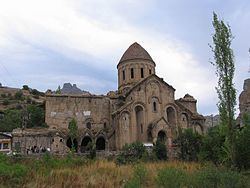Groundbreaking 963 | Completed 973 | |
 | ||
Similar Bana cathedral, Otkhta, Ishkhani, Khakhuli Monastery, Khandzta | ||
Oshki or Oshk Vank (Georgian: ოშკი Oshki, Armenian: Օշկ վանք Oshk Vank, Turkish: Öşk Vank/Çamlıyamaç) is a Georgian monastery from the second half of the 10th century located in the historic province of Tao, now part of the territory of Turkey. The main church, dedicated to St John the Baptist, was built between 963 and 973. The Monasterys location in Turkey is in the village of Çamlıyamaç, in northeastern Erzurum Province, bordering Artvin Province. Other sources describe it as an Armenian monastery. The monastery is disputed by the Armenians.
Contents

Oshki monastery was a major centre of Georgian literature and enlightenment during the Middle Ages.
oshki
Architectural sculpture and figurative reliefs

The construction of the monastery at Osk/Oshki was sponsored by the Georgian Kings Bagrat eristavt-eristavi (prince of princes) and David III Bagrationi Kuropalates.

The blind arches are an important part of the whole decoration. In Oshki they stretch along the outer walls of the church in the south, east and north. It is an early example of the use of decorative blind arches on the facades. They divide the wall in line with the general architectural rhythm. The central part of the facade is mainly decorated with bas-reliefs.

Bas-reliefs, placed high above the central arch, are given the place of honour on the southern facade, which is the main facade of the church. They stand out from the flat surface. The eagle with an animal in his talons probably symbolises victory, and the whole sculptural composition the triumph of the heavenly forces represented by the archangels Michael and Gabriel.
In the province of Tao the power lay in the hands of the ruling dynasty of the Bagrationi, whose members Bagrat eristavt-eristavi and David Magistros are depicted lower down on the same facade, near the deesis, to show that the heavenly forces were the family's patrons.
The figures are well proportioned, elegant in contour and form. The static postures of earlier donor portraits give way to free movement, and an equal attempt can be traced in the near three-dimensional renderings of the archangels and the deesis of the southern facade, as well as on a column in the southern gallery. The decorative system of the Oshki church also includes the low reliefs characteristic of the so-called transitional period in medieval Georgian art (8th - 10th centuries), when the old style had not yet given way completely, and new ways were evolving. Sculptors of the different generations must have worked on it. The church in Oshki already shows the tendencies that would eventually develop in the 11th century.
Inscription №1
The first inscription in Oshki temple is drawn with Sanguri (Georgian: სანგური) color and is located over the southern main entrance to the temple. Nowadays 12 lines still exist. All inscriptions are written with Mrgvlovani, the earliest version of Georgian script. The original can be seen on the illustration in the right. The first scientist who explored this inscription was Marie-Félicité Brosset, a French orientalist who specialized in Georgian and Armenian studies. Later these inscriptions were researched by Ekvtime Takaishvili and Wachtang Djobadze. As noted by Wachtang Djobadze, the first inscription gives a lot of information about the temple. It mentions the names of Ktetors of the church - Georgian kings Bagrat Eristavt-Eristavi and David III Kuropalates. Also there is information about architect of the church - someone called Grigol.
- მოწყალებითა ღ(მრ)თისაჲთა რ(ომე)ლი სცავს ყ(ოვე)ლთა მოშ(ი)შთა მ(ი)სთა და წარმოჳმართ(ე)ბს მოყოჳარეთა სახელისა მისისათა ყ(ოვე)ლთა ს(ა)ქმ(ე)
- თა კ(ე)თ(ი)ლთა ამის წ(მი)დისა ს(ა)მ(ე)ბ(ი)სა სარწმოჳნოვებ(ი)თა და მ(ეო)ხ(ე)ბ(ი)თა წ(მი)დისა დ(ე)დოფლისა ჩ(უე)ნისა ღ(მრ)თ(ი)სმშობ(ე)ლისაჲთა მ(ა)დლითა წ(მი)დ(ა)ჲსა ძ(ე)ლისაცხოვრებისაჲ
- თა შეწ(ე)ვნითა და მეოხ(ე)ბ(ი)თა დიდებოჳლისა ნათლი[ს]მცემლისაჲთა და ყ(ოვე)ლთა წმიდაჲთაჲთა რ(ომელ)ნი საოჳკოჳნითგ(ა)ნ სათნო ეყ(უ)ნ(ე)ს ღ(მერ)თსა ამათ ყ(ოვე)ლთა
- წმიდათა სადიდებ(ე)ლ(ა)დ და საქებ(ე)ლ(ა) იწყ(ე)ს ღ(მრ)თივ გოჳრგოჳნოს(ა)ნთა მ(ე)ფ(თ)ა ჩ(უე)ნთა შ(ე)ნ(ე)ბ(ა)დ ამის წმიდისა ს(ა)ყდრისა რ(ა)თა ამას შ(ი)ნა აღესროჳლებოდიან დღესა
- სწაოჳლნი და შეიმკვებოდიან ჴსენებ(ა)ნი წმიდათანი ვ(ითარც)ა წერილ არს ჴსენებასაწმიდათასა ეზიარებოდ(ე)თ ამათ ყ(ოვე)ლთა წმიდათა სოჳრვილითა
- ამათ დიდეოჳ[ლ]თა მ(ე)ფ(ე)თა ჩ(უე)ნთა ოჳშოჳრვ(ე)ლ ყ(უ)ნენ საფას(ე)ნი წარმავ(ა)ლნი წარ[ო]ჳვალისა მ(ი)სთოჳის რ(ა)თა ყ(ოველ)ნი წმიდანი შემწ(ე)დ მოიგნენ და ღმერთმან შ(ეე)წ(იე)ნ ორთავე
- ცხოვრებ(ა)თა ძ(ე)თა ღ(მრ)თ(ი)ვ კოჳრთხეოჳლისა ადარნასე კოჳრაპალატისატა ბ(ა)გრ(ა)ტ ერისთავთა ერისთ(ა)ვმ(ა)ნ დავით მაგისტროსმ(ა)ნ სამებამ(ა)ნ წმიდამან
- სამნივე დაიფარენ მორჯოჳენითა თ(ჳ)სითა და ა(დი)დ(ე)ნ ორთავე ცხორებ(ა)თა და მე გრიგოლ ღირს მყო ღ(მრერთმა)ნ მსახოჳრებ(ა)სა ამას მ(ა)თსა ღ(მრ)თისა მიმართ და მე ვიყ
- ავ სა[ქ]მესა ზ(ედ)ა-მ[დ]გომი და არწმოჳნა ღ(მერთმა)ნ გონებასა მ(ა)თსა ერთ-გოჳლობაჲ ჩ(ე)მი მ(ო)ნისა მ(ა)თისაჲ ესე იყო გალატოზთა და მოქმედთა მიზდი და აზავერთა მექოჳიშე
- თაჲ რ(ომე)ელ წელიწადსა წარეგების დრამაჲ :კ: ათასი ღოჳინოჲ ფ(ისო)სი :ჭ: რკინაჲ ლიტრი :ნ: ხოჳარბალი გრივი :ს:მ:ი: გალატოზი და ხო[ჳ]როჲ და მჭედელი რ(ომე)[ლმა]რადის შ(უ)რებო
- და ჲ:ი: ჴ(ა)რი რ(ომ)ელ ქვასა კრ(ე)ბდა :ლ: ჯორი და სხ(უ)აჲ აზავერი რ(ომე)ლ გრიგოჳლ-წმიდით სპონდიკსა კრ(ე)ბდა :ლ: სხოჳაჲ აზავერი რ(ომე)ლ [-] [კრ(ე)]ბდა :ჲ: [-]
- ჲდა [-] [ყი]ერი და მოქმედი :პ:
